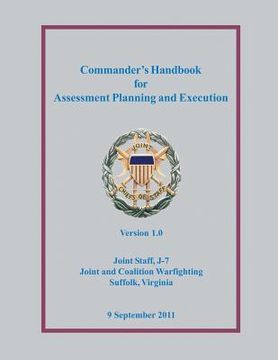Reseña del libro "Commander's Handbook for Assessment Planning and Execution (en Inglés)"
This handbook provides an understanding of the processes and procedures being employed by joint force commanders and their staffs to plan and execute assessment activities. It provides fundamental principles, techniques, and considerations related to assessment that are being employed in the field and are evolving toward incorporation in joint doctrine. Furthermore, this handbook supplements doctrinal publications by providing detailed guidance to conduct effects assessment, task assessment, and deficiency analysis. Commanders, assisted by their staffs and subordinate commanders, along with interagency and multinational partners and other stakeholders, will continuously assess the operational environment and the progress of the operation toward the desired end state in the time frame desired. Based on their assessment, commanders direct adjustments, thus ensuring the operation remains focused on accomplishing the mission. Assessment is applicable across the range of military operations. It offers perspective and insight, and provides the opportunity for self-correction, adaptation, and thoughtful results-oriented learning. Assessment is a key component of the commander's decision cycle, helping to determine the results of tactical actions in the context of overall mission objectives and providing potential recommendations for the refinement of future plans. Assessments provide the commander with the current state of the operational environment, the progress of the campaign or operation, and recommendations to account for discrepancies between the actual and predicted progress. Commanders then compare the assessment against their vision and intent and adjust operations to ensure objectives are met and the military end state is achieved. First, assessment must determine "where we are." The assessment process must examine the data received and determine, in relation to the desired effects, the current status of the operation and the operational environment. This is the most basic and fundamental question that assessment must answer. The second fundamental issue that assessment must address is "so what and why" (i.e., what does the data mean and what is its significance)? To answer this question, the assessment team will examine the measure of effectiveness indicators, both individually and in relation to each other. Finally, and perhaps most importantly, assessment must begin to address the "what's next?" Assessment must combine the analysis of the "where we are" and the "so what" and develop thoughtful, logical guidance for the command's planning efforts. Assessments are interrelated and interdependent. Although each level of assessment may have a specific focus and a unique battle rhythm, together they form a hierarchical structure in which the conduct of one level of assessment is crucial to the success of the next. Theater strategic and operational-level assessment efforts concentrate on broader tasks, effects, objectives, and progress toward the end state, while tactical-level assessment primarily focuses on task accomplishment. This handbook provides users with a pre-doctrinal reference describing how to conduct assessment execution and planning. Its primary purpose is to improve the US military's assessment process through educating the user on basics, best practices, and processes. This handbook was developed based on observations at combatant commands as well as joint task force staffs. It was developed in close coordination with, and used significant input from, both civilian and military subject matter experts. Assessment is a collaborative effort between the joint force, interagency and multinational partners, and other stakeholders. As such, this handbook addresses the necessity for an inclusive assessment process and effort at every level. It also presents some assessment resources developed by other stakeholders and currently in use throughout the world.

